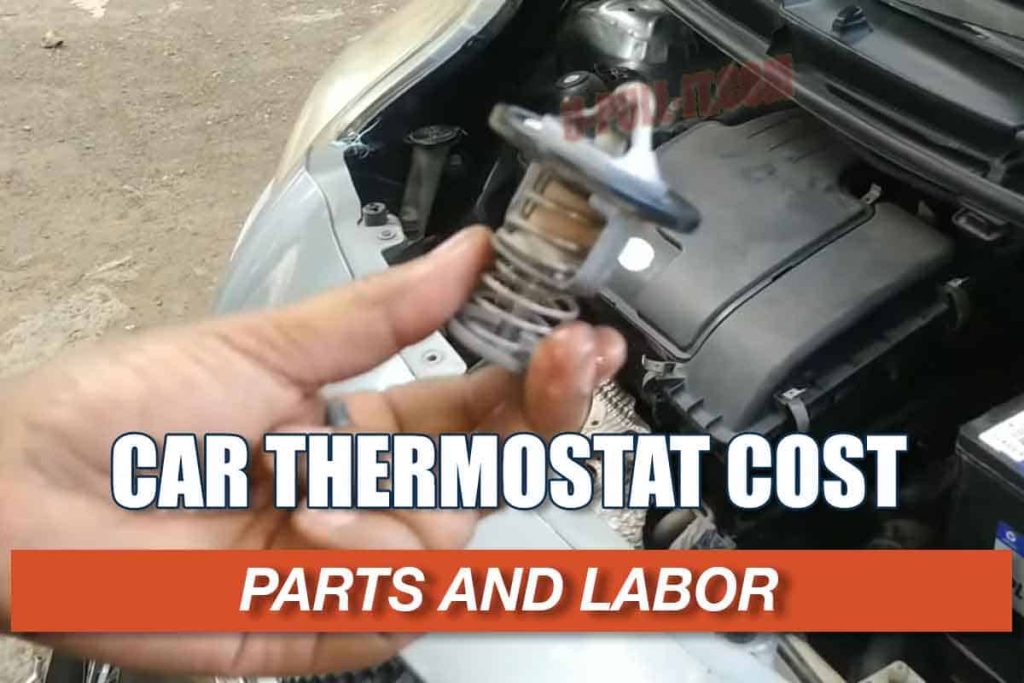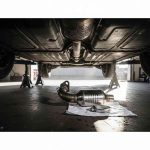Replacing a car thermostat is an essential maintenance task that ensures your vehicle’s engine operates at the optimal temperature. The thermostat is a small but vital component of your car’s cooling system that helps regulate coolant flow to the engine. Over time, however, the thermostat may wear out and need replacement to prevent engine damage and costly repairs.
When the coolant system malfunctions, not only does your vehicle’s performance suffer, but its engine coolant efficiency can also take a hit. This is one of the key symptoms to watch out for in vehicles. Ignoring a faulty thermostat in your car’s coolant system isn’t an option unless you’re ready to risk potential damage to the engine gaskets and operating temperature.
This is particularly true when the system is closed. In this post, we’ll delve into the cost implications of replacing a crucial part – the car thermostat. The thermostat is integral to maintaining optimal vehicle health by regulating the engine coolant and ensuring the operating temperature is ideal. This content is essential for understanding your car’s needs.
The average cost for a Thermostat Replacement is between $95 and $539.

Car thermostat replacement costs can vary. Thermostat replacement costs depend on your car’s make and model, the cost of the new thermostat part, labor charges, additional expenses, and where you live.
For example, replacing the thermostat on a 2011 Chrysler 200 Spect can cost anywhere from $150 to $190, including parts and labor.
Variance in Costs Based on Car Make and Model
Different cars mean different costs. For example, as part of maintenance costs, a Honda Civic might cost less to replace the thermostat than a BMW X5. The car parts are priced differently because of the car brand.
Labor Charges Influence on Total Replacement Cost
Mechanics charge for their time. If replacing a thermostat in one car takes longer compared to another, the cost will be higher. Always ask for an estimate before getting work done.
Potential Additional Expenses
Sometimes other things need changing too. You might need new coolant or a gasket change when replacing your thermostat. These extras add to your bill.
Geographic Location’s Impact on Price Range
Where you live affects the price, too. In big cities like New York or Los Angeles, the car thermostat replacement cost may be higher than in smaller towns.
Remember, these are average costs. Your actual cost could be lower or higher depending on various factors.
The Role of Coolant in Thermostat Functioning
Coolant is vital for your car’s engine. It helps manage the heat produced during combustion.
Heat Transfer Medium
Engine coolant, often called antifreeze, transfers heat from the engine to the radiator. This flow cools down your engine and prevents overheating.
- Engine Temperature: High temperatures can damage your engine. To avoid this, the coolant absorbs excess heat.
- Radiator: The radiator dispels the heat absorbed by the coolant into the atmosphere.
Thermostat Control
The thermostat controls how much coolant flows within your car’s cooling system.
- Valve Mechanism: When your car reaches its operating temperature, the thermostat valve opens. This action allows coolant to flow from the engine to the radiator.
- Water Pump: The water pump pushes this hot coolant towards the radiator for cooling.
Importance of Proper Coolant Levels
Maintaining proper levels of coolant is crucial for optimal functioning of your vehicle.
- System Efficiency: A well-maintained coolant level ensures that there’s enough medium to absorb and transfer heat.
- Prevents Damage: Low or high levels can lead to engine failure or other serious issues.
Consequences of Wrong Coolant Type
Using a wrong type or poor-quality coolant can have serious consequences on your vehicle’s performance and longevity.
- Engine Health: An inappropriate type could fail to cool effectively, leading to an overheated engine.
- Replacement Cost: If not addressed promptly, it may result in needing a costly car thermostat replacement job done by a mechanic.
5 Signs of a Bad Thermostat

A faulty thermostat can cause car issues. Here are five signs that indicate your car’s thermostat might need replacement.
Overheating Engine
An overheating engine is a common sign of a bad thermostat. If the thermostat is stuck closed, it won’t allow coolant to flow. This causes the engine to overheat.
For example, if you notice steam from under your hood while driving, pull over immediately. It might be due to a faulty thermostat causing the engine to overheat.
High Fuel Consumption
A bad thermostat can lead to unusually high fuel consumption. The improper temperature regulation forces the engine to work harder than necessary, burning more fuel.
Statistics show cars with faulty thermostats consume up to 7% more fuel than those with functioning ones.
Fluctuating Temperature Gauge
Fluctuating temperature gauge readings are another warning sign. A working thermostat maintains stable temperature levels in your car’s engine.
If you notice frequent changes on your dashboard’s temperature gauge, it could be due to a malfunctioning thermostat.
Cold Air From the Heater
Lastly, cold air blowing from your heater may indicate a stuck-open thermostat. Instead of warming up as it should, the constant flow of coolant keeps the engine too cool.
In one case study, a driver reported his heater blowing cold air in winter despite having set it at maximum heat level; his mechanic identified the problem as a stuck-open thermostat.
Detailed Explanation of Thermostat Types
Traditional vs. Modern Thermostats
Thermostats come in two types. The old-school mechanical ones and the new-age electronic versions.
Mechanical thermostats use a spring mechanism. They expand and contract with temperature changes. On the other hand, electronic thermostats use sensors. These devices detect temperature changes electronically.
Impact on Vehicle Performance
Different thermostat types affect your car differently. Mechanical ones are simple but less accurate. Electronic models offer precision but can be complex.
For instance, an electronic thermostat provides exact temperature control. This means better engine performance and fuel efficiency.
Choosing the Right Type
Your vehicle’s specifications matter when choosing a thermostat type. Old cars often work best with mechanical thermostats. Newer or luxury models may require electronic versions for optimal performance.
Consider this point when deciding between a traditional or modern thermostat.
Cost Implications
Costs vary between thermostat types, too. Mechanical parts are generally cheaper than their electronic counterparts.
For example, replacing a mechanical thermostat might cost around $50-$200, depending on your vehicle model and part quality. An electronic replacement could run you up to $300 or more in some cases.
In addition to the part cost, consider labor charges too. Mechanics charge differently for installing different types of thermostats due to the varying levels of complexity involved in each case.
Factors Influencing Car Thermostat Replacement Cost
Car thermostat replacement cost can vary. This depends on several factors.
Complexity Level and Labor Charges
Replacing a car thermostat is not always straightforward. It can be complex to access the thermostat location in some cars. The more complex it is, the higher the labor charges.
For instance, if your mechanic needs extra time to reach the thermostat, this will increase labor costs.
Quality and Brand of New Thermostat
The type of new thermostat you choose also affects the cost. High-quality thermostats from reputable brands are typically more expensive.
- A premium brand might cost $50, while a budget-friendly option might be around $20.
- Remember, cheaper isn’t always better. Quality matters for long-term performance.
Additional Services Impacting Final Bill
Sometimes, additional services are needed during car thermostat replacement. These could include a system flush or leak test.
- If these services are included, they will add to your final bill.
- For example, a system flush could add an extra $100 to your bill.
Dealership vs Local Garage
Where you choose to have your car serviced also impacts the cost. Dealerships are usually more expensive than local garages.
- A dealership might charge $200 for a car thermostat replacement.
- However, a local garage might do it for half that price at $100.
Evaluating Fairness in Quoted Replacement Prices
When replacing your car thermostat, understanding the cost is crucial. Let’s break down how to evaluate fairness in quoted replacement prices.
Obtain Multiple Quotes
Getting multiple quotes helps you compare costs. It allows you to assess which shop offers a fair price for the same service.
- Contact different dealerships
- Ask friends and family for recommendations
- Use online platforms to get estimates
Understand Labor and Parts Breakdown
A quote should include labor and parts costs. Understanding this breakdown can help you see where your money goes.
- Labor costs depend on the mechanic’s experience
- Parts cost may vary based on brand or quality
Check Included Services
Ensure your quote includes all necessary services for a full review of the replacement process. Some shops might charge extra for certain procedures.
- Does it cover coolant refill?
- Is system testing included?
Verify with Average Market Rates
Finally, verify your quoted price with average market rates. This will give you an idea if you’re being overcharged or undercharged.
To find out average rates:
- Research online for average costs of car thermostat replacements
- Consult with local mechanics or car enthusiasts
Remember, a higher price doesn’t always mean better service, and a lower rate might not always be a bargain!
Importance of Timely Thermostat Replacement
A car’s thermostat is vital. Replacing it on time prevents damage and saves money.
Prevention of Engine Damage
The thermostat controls engine temperature. If it fails, the engine can overheat. This may lead to severe damage. For instance, a broken head gasket or a cracked engine block might occur.
Maintain Fuel Efficiency
Optimal operating temperature is key for fuel efficiency. A faulty thermostat can disrupt this balance. This leads to increased fuel consumption and higher costs in the long run.
Avoid Costly Repairs
Prolonged malfunctioning of the thermostat can be expensive. It may cause damage to the expansion tank or other components. Regular maintenance helps avoid these costly repairs.
Consistent Cabin Heating
During winter, a working thermostat ensures consistent cabin heating. Without it, you might face cold drives! So timely replacement not only keeps you warm but also enhances your driving experience.
Remember, early detection of failure is crucial for timely repair or replacement under warranty terms. Being proactive about your car’s health saves both time and money in the long run.
How Difficult Are Thermostats to Replaced?
The thermostat in your car plays a crucial role, and its timely replacement can save you from hefty repair costs down the line. Recognizing the signs of a bad thermostat and understanding what influences the replacement cost are key to making an informed decision. Remember, ensuring fair pricing is as important as getting it replaced promptly to avoid further damage.
Don’t let a faulty thermostat take you off the road. Act now! Consult with a trusted mechanic or auto service provider to get an accurate quote for your car’s thermostat replacement. Knowledge is power, and you’re now equipped with all you need about this vital component of your vehicle.
FAQs
What is the average cost for a car thermostat replacement?
The average cost for replacing a car’s thermostat typically ranges between $95 and $539, depending on various factors such as make and model of the vehicle, labor costs, and location.
How can I tell if my car’s thermostat is faulty?
Check The hoses going in and out of your engine, the ones that carry the coolant; if one is hot and the other one is not, then you have a defective thermostat.
Can I replace my car’s thermostat myself?
While it’s possible to replace your car’s thermostat yourself if you have some mechanical knowledge and tools, it’s recommended to seek professional help due to potential complications that could arise during the process.
How often should I replace my car’s thermostat?
There isn’t a set schedule for replacing thermostats since they can last anywhere from 10 years to beyond. However, checking them every time you have scheduled maintenance or notice any failure symptoms is wise.
Does ignoring a faulty thermostat cause more damage?
Yes. Ignoring a faulty thermostat can lead to serious problems like overheating which could potentially damage your engine leading to expensive repairs.
What is a car thermostat, and why does it need replacement?
What is the function of a car thermostat?
A car thermostat is a valve between the engine and the radiator that regulates the engine temperature by controlling the coolant flow. It has a temperature-sensitive valve that opens and closes as needed to maintain the ideal operating temperature for the engine.
Why does a car thermostat need replacement?
With regular use, the car thermostat can become worn out or malfunction. A faulty thermostat can get stuck open, causing the engine to run too cold and reducing fuel efficiency. On the other hand, a stuck closed thermostat can result in overheating, leading to potential engine damage. To prevent these issues, it is important to replace a faulty thermostat promptly.
When should you consider replacing your car thermostat?
Several signs indicate a bad car thermostat. If you notice that your engine is running hotter or colder than usual, it could be a sign of a malfunctioning thermostat. Other symptoms include fluctuating engine temperature, coolant leaks, and a check engine light. If you experience any of these issues, having your car thermostat inspected and potentially replaced is important.
What are the signs of a bad car thermostat?
What are the common symptoms of a faulty car thermostat?
Apart from the signs mentioned earlier, other indicators indicate that your car thermostat may be faulty. These include poor fuel efficiency, reduced engine performance, and decreased heat output from the heater. If you notice any of these symptoms, it is advisable to have your car thermostat checked by a professional.
How does a bad car thermostat affect engine performance?
A bad car thermostat can disrupt the engine’s temperature regulation, causing it to run too hot or too cold. This can lead to decreased engine performance, reduced fuel efficiency, and potential damage to engine components. Additionally, a malfunctioning thermostat can cause issues with the car’s cooling system, leading to overheating and further engine damage.
Can a bad car thermostat cause engine damage?
Yes, a bad car thermostat can cause engine damage if not addressed promptly. A stuck closed thermostat, for example, can cause the engine to overheat, leading to potential damage to gaskets, radiator hoses, and even the engine block. Over time, the excessive heat can cause significant and costly damage, necessitating extensive repairs.
How much does it cost to replace a car thermostat?
What is the average cost of car thermostat replacement?
The cost of replacing a car thermostat can vary depending on several factors, such as the make and model of the vehicle and the location of the repair shop. On average, the cost of a car thermostat replacement ranges from $150 to $300, including parts and labor.
What factors can affect the cost of car thermostat replacement?
Several factors can affect the cost of car thermostat replacement. The type of thermostat needed, the installation’s complexity and the repair shop’s labor rates can all impact the final cost. Additionally, the overall cost may increase if other components, such as the radiator hose or gasket, need replacement.
Is it possible to replace a car thermostat yourself to save on costs?
While it is possible to replace a car thermostat yourself, it is generally recommended to have it done by a professional. The thermostat is a crucial component of the engine’s cooling system, and an incorrect installation can lead to further issues. It’s best to leave thermostat replacement to experienced mechanics who can ensure it is done correctly and efficiently.
Who should you consult for car thermostat replacement?
A local mechanic
Should you go to a mechanic for car thermostat replacement?
Yes, it is advisable to go to a mechanic for a car thermostat replacement. A mechanic has the knowledge, experience, and tools to diagnose and replace the faulty thermostat accurately. They can also inspect the overall health of the cooling system and address any other potential issues.
What are the benefits of having a professional replace your car thermostat?
Having a professional replace your car thermostat offers several benefits. They have the expertise to identify any underlying problems that may be causing the thermostat to malfunction. Additionally, they can ensure the correct type of thermostat is used and installed properly, preventing future issues and extending the cooling system’s lifespan.
Are there any alternative options for car thermostat replacement?
While going to a mechanic is the most common option for car thermostat replacement, there are alternative options available. Some car owners with mechanical know-how and experience may choose to replace the thermostat themselves. However, having the necessary skills and knowledge to ensure a proper installation and prevent any further issues is important.
What regular maintenance should be done to prevent car thermostat problems?
Regular maintenance is key to preventing car thermostat problems. It is important to follow the manufacturer’s recommended service intervals and have the cooling system inspected and flushed as necessary. Regularly checking coolant levels and ensuring proper coolant mixtures can also help maintain the thermostat’s functionality.
Can using quality coolant help in prolonging the lifespan of a car thermostat?
Yes, using quality coolant can help prolong the lifespan of a car thermostat. Quality coolant contains additives that prevent corrosion and deposit build-up, ensuring the thermostat and other components of the cooling system remain clean and functional. It is advisable to use the coolant specified by the vehicle manufacturer to maintain optimal performance.
What common mistakes can lead to a vehicle’s thermostat failure?
Several common mistakes can lead to car thermostat failure. Improper coolant mixture, such as using straight water instead of a coolant mixture, can cause corrosion and deposit build-up, leading to thermostat malfunction. Additionally, neglecting regular maintenance, such as failing to flush the cooling system or ignoring coolant leaks, can contribute to car thermostat failure.
What could indicate a faulty thermostat in my car?
A faulty thermostat usually leads to problems such as engine overheating and poor engine performance. Symptoms like these should indicate that the thermostat might be stuck open or stuck closed.
What does a car thermostat do?
A car thermostat regulates the flow of coolant to the radiator. When the engine is cold, it remains closed. The thermostat opens as the engine warms up, allowing coolant flow to the radiator and preventing overheating.
What happens when the thermostat is stuck open?
If the thermostat is stuck open, it can lead to the engine not getting warm enough. This can cause poor fuel economy and wear and tear on engine components.
What if the thermostat is stuck closed?
A stuck closed thermostat is a much more serious issue. This means the thermostat is not allowing the coolant to flow to the radiator, which can lead to the engine overheating and potentially causing major damage.
How often should a thermostat be replaced?
The life of your thermostat varies depending on the type of car and its usage. However, whenever you have problems such as overheating or poor performance when driving your car, consider replacing your thermostat as soon as possible.
Can I drive my car with a bad thermostat?
While you may be able to drive for a short period, driving your car with a bad thermostat isn’t recommended. The risk of the engine overheating can lead to more severe and expensive problems down the road. It’s advisable to take your car to a mechanic immediately.
What possible damage can a faulty thermostat cause?
A faulty car thermostat can lead to engine overheating, which could damage the engine and require expensive repairs. These could include a timing belt or radiator hose replacement.
What does it cost to have a thermostat replaced in my car?
The average cost for car thermostat replacement can vary depending on the type of car, make, model, and the mechanic. However, you can usually expect to pay between $90 and $550, including the cost of a replacement thermostat and labor.
Can I replace a car thermostat myself?
Although it is possible to replace a car thermostat yourself, it may be complex as it involves removing the thermostat housing and other components like the radiator hose. It may also not be cost-effective if you don’t have the required tools. For these reasons, it’s recommended to have a mechanic handle car thermostat replacements.
How can I keep my car thermostat in its best condition to avoid frequent replacements?
Regular vehicle maintenance is critical. It helps ensure your car operates within the best temperature range and keeps your thermostat and engine healthy. Also, if your mechanic recommends a thermostat replacement during a service, it is usually best to follow their advice to avoid the thermostat going bad and leading to more expensive repairs.




